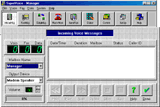
Directcom 56k modem
Review date: 18 November 1998. Last modified 03-Dec-2011.
Shopping for a 57,600 bit per second modem priced around the $150 mark (Australian dollars, November 1998)? You’ve got a few options. For a name brand you’re looking at at least $50 more, but there are several off-brand models with proper Rockwell chipsets for around $150.
Directcom’s inventively named "56Kbps External Modem" is one of them, and not a bad choice. It’s a data/fax/voice modem with microphone and speaker jacks for speakerphone operation, plain beige styling and the industry standard Rockwell chipset.
It comes with Rockwell’s k56flex protocol built in, but can be upgraded to v.90 spec with the firmware update found at http://www.puretek.com/html/upgrade.html – a little detective work revealed that the Directcom is actually a rebadged Puretek modem. This page confusingly tells you that the update is only available to US customers (different countries need different updates to comply with phone regulations), but provides a "Non-US customer" link that takes you to the update. Mind you, Puretek’s whole site looks as if it was put together with the monitor off.
When you run the firmware updater, it complains about not being able to ID the modem and presents dire and perfectly correct warnings about the perils of updating a modem with the wrong firmware and/or interrupting the update. But it backs up the old firmware and updates the modem just fine. If you need k56flex again, you just run the updater again and go back to the backup.
Software and docs
The Directcom comes with a CD-ROM containing the popular SuperVoice 2.2 package, which is the 1997 version of the software (SuperVoice is up to version 4 now) but still works well. The interface is one of those ugly Windows 3.1 hangovers, but fax, data and voice mail is all handled, with remote access so you can use your computer as a quite elegant answering machine-cum-fax collector that you can talk to from any tone phone, just like a regular answering machine. Bundled software with cheap Taiwanese gear is usually pretty dire, but this is above the average.
Mind you, a lot of modems come with SuperVoice, so it’s far from a unique selling point. You can, by the way, download a free 2.2F update for SuperVoice from www.supervoice.com.
The CD-ROM also contains modem drivers for Windows 95/98, which is just as well, because the Directcom isn’t in Windows 98’s monster modem driver list under its own name or as a Puretek product.
The modem manual is sparse, but not many people need four hundred pages on the intricacies of AT commands any more. The software documentation is on the CD-ROM, and is passable. If the drivers didn’t work, the slim manual would be annoying, but they do so it’s not.
Overall
This is about as cheap as you can get a decent 56k modem at the moment. Netcomm’s Roadster II V.90 sells for around $210, and supports both K56flex and V.90 out of the box, automatically detecting which is in use. This auto-detection is filtering down into off-brand modems around $150 now, but it’s not an important feature, since most people need only one protocol and your dealer should be able to provide the upgrade software for you, if needed.
If you’re a real pennypincher you can get a 56k modem for a few dollars less, but to make sure you’re comparing apples with apples, check that other bargain modems come with a serial cable (the Directcom has a double-header 9/25 pin cable) and a phone cable (the Directcom has a modular to Australian lead included). Many el cheapo modems lack one or both of these items, which explains the saving.
For the money, this is a good unit. It’s well made, it comes with OK software, the drivers work and the upgrade procedure is simple enough. It’s only one horse in a pretty crowded race, but it’s a good bet.
Pros: |
Cons: |
|
|


